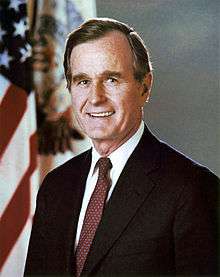United States presidential election in Ohio, 1988
| | ||||||||||||||||||||||||||||||||
| ||||||||||||||||||||||||||||||||
| ||||||||||||||||||||||||||||||||
|
| ||||||||||||||||||||||||||||||||
| County Results
Dukakis—60-70%
Dukakis—50-60%
Bush—50-60%
Bush—60-70%
Bush—70-80% | ||||||||||||||||||||||||||||||||
| ||||||||||||||||||||||||||||||||
The 1988 United States presidential election in Ohio took place on November 8, 1988. All 50 states and the District of Columbia, were part of the 1988 United States presidential election. Ohio voters chose 23 electors to the Electoral College, which selected the President and Vice President.
Ohio was won by incumbent United States Vice President George H. W. Bush of Texas, who was running against Massachusetts Governor Michael Dukakis. Bush ran with Indiana Senator Dan Quayle as Vice President, and Dukakis ran with Texas Senator Lloyd Bentsen.
Ohio weighed in for this election as 2% more Republican than the national average.
Partisan background

The presidential election of 1988 was a very partisan election for Ohio, with more than 99% of the electorate voting for either the Democratic or Republican parties.[1] Most counties in the state turned out more for Bush than Dukakis. Two notable exceptions to this trend were Cleveland's Cuyahoga County, and residents of several counties on the Eastern border with Pennsylvania, who voted largely for Dukakis.
Republican victory
Bush won the election in Ohio with a solid 11 point landslide. As a historical swing state, the decisive election results in Ohio are reflective of a nationwide reconsolidation of base for the Republican Party, which took place through the 1980s. Through the passage of some very controversial economic programs, spearheaded by then President Ronald Reagan (called, collectively, "Reaganomics"), the mid-to-late 1980's saw a period of economic growth and stability. The hallmark for Reaganomics was, in part, the wide-scale deregulation of corporate interests, and tax cuts for the wealthy.[2]
Dukakis ran on a notably socially liberal agenda, and advocated for higher economic regulation and environmental protection. Bush, alternatively, ran on a campaign of continuing the social and economic policies of former President Reagan - which gained him much support with social conservatives and people living in rural areas, who largely associated the Republican Party with the economic growth of the 1980s. Additionally, while the economic programs passed under Reagan, and furthered under Bush and Clinton, may have boosted the economy for a brief period, they are criticized by many analysts as "setting the stage" for economic troubles in the United State after 2007, such as the Great Recession.[3]
| Elections in Ohio | ||||||||||
|---|---|---|---|---|---|---|---|---|---|---|
.svg.png) | ||||||||||
|
||||||||||
|
|
||||||||||
Results
| United States presidential election in Ohio, 1988 | |||||
|---|---|---|---|---|---|
| Party | Candidate | Votes | Percentage | Electoral votes | |
| Republican | George H. W. Bush | 2,416,549 | 55.00% | 23 | |
| Democratic | Michael Dukakis | 1,939,629 | 44.15% | 0 | |
| New Alliance Party | Lenora Fulani | 12,017 | 0.27% | 0 | |
| Libertarian | Ron Paul | 11,989 | 0.27% | 0 | |
| U.S. Labor Party | Lyndon LaRouche | 7,733 | 0.18% | 0 | |
| Socialist Equality Party | Edward Winn | 5,432 | 0.12% | 0 | |
| Write-Ins | 216 | >0.01% | 0 | ||
| Workers World | Larry Holmes | 134 | >0.01% | 0 | |
| Totals | 4,393,699 | 100.0% | 23 | ||
See also
References
- ↑ "Dave Leip's Atlas of U.S. Presidential Elections". Uselectionatlas.org. Retrieved 2013-07-21.
- ↑ "Since 1980s, the Kindest of Tax Cuts for the Rich". The New York Times. 2012-01-18. Retrieved 2013-07-21.
- ↑ Jerry Lanson (2008-11-06). "A historic victory. A changed nation. Now, can Obama deliver?". Christian Science Monitor. Retrieved 2013-07-21.



